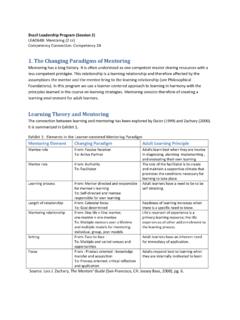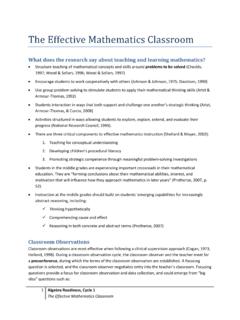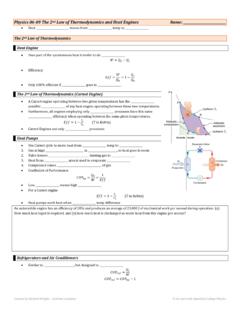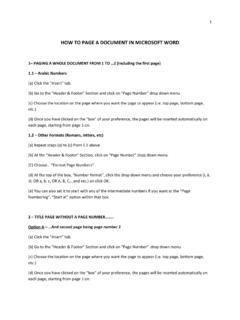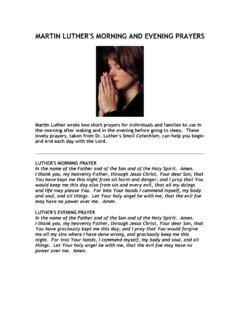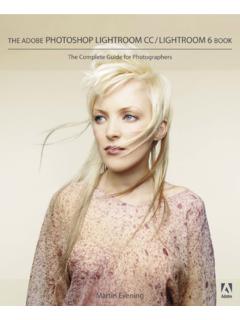Transcription of EVENING OR MORNING: WHEN DOES THE BIBLICAL DAY …
1 Andrews University Seminary Studies, Vol. 46, No. 2, 2008 Andrews University OR morning : when does THE BIBLICAL DAY BEGIN?J. Am A n dA mcGu i r eBerrien Springs, MichiganIntroductionThere has been significant debate over when the BIBLICAL day begins. Certain BIBLICAL texts seem to indicate that the day begins in the morning and others that it begins in the EVENING . Scholars long believed that the day began at sunset, according to Jewish tradition. Jews begin their religious holidays in the EVENING ,1 and the BIBLICAL text mandates that the two most important religious feasts, the Passover2 and the Day of Atonement,3 begin at sunset. However, in recent years, many scholars have begun to favor a different view: the day begins in the morning at sunrise.
2 Although it may be somewhat foreign to the ancient Hebrew mind to rigidly define the day as a twenty-four-hour period that always begins and ends at the same time,4 the controversy has important implications for the modern reader. The question arises: when does the Sabbath begin and end? The purpose of this paper is to examine whether the day begins in the morning or in the EVENING by analyzing the sequence of events on the first day of creation (Gen 1:2-5), examining texts that are used to support both theories, and then determining how the evidence in these texts relates to the religious observances prescribed in the Torah. Because of time constraints, I do not explore the question of whether or not the days in Gen 1 are literal.
3 For the purposes of this paper, I am assuming that the days described in Gen 1 are, in fact, twenty-four-hour does Genesis 1:2-5 State That the Day Begins?Genesis 1:2 states that before God began his creative work, the earth was formless, void (Whbow); Whto), and dark (%v,xo). Once the text establishes that the world was in a state of darkness and chaos, the BIBLICAL narrative records God s first creative work found in the Bible: And God said, Let there be light. Then there was light. 5 1U. Cassuto, A Commentary on the Book of Genesis, trans. Israel Abrahams, 4th ed., 3 vols. (Jerusalem: Magnes, 1961), 1:29; and H. Niehr, br,[,, in Theological Dictionary of the Old Testament, ed. G. Johannes Botterweck, Helmer Ringgren, and Heinz-Josef Fabry (Grand Rapids: Eerdmans, 2001), 12:18; Lev 23 23 J.]
4 Heawood, The Beginning of the Jewish Day, Jewish Quarterly Review 36/4 (1946): m i nA r y St u d i eS 46 (Au t u m n 2008) In v. 4, God separates the light (which he had just created) from the darkness (which was already in existence). In v. 5, he names them day (~Ay) and night (hl);y>l);), respectively. A formula is then introduced that will be repeated after each day of creation: And it was sunset, then it was sunrise, day X (dx);a, ~Ay rq,bo-yhiy>w: br,[,-yhiy>w:). For centuries, scholars interpreted this statement to be a summary of what had just happened: first there was EVENING (darkness) and then there was morning (light), making one day. In recent years, however, this assumption has been called into Many scholars are moving toward the morning theory.]
5 P. J. Heawood argues that the Jewish day begins in the morning , as did A. Dillman fifty years before U. Cassuto interprets Gen 1:5 this way: when day-time had passed, the period allotted to darkness returned (and there was EVENING ), and when the night-time came to an end the light held sway a second time (and there was morning ), and this completed the first calendar day (one day), which had begun with the creation of light. 8 N. Sarna believes that br,[, signals the end of the creative activity and that rq,Bo signals the renewal of creative activity on the second Other scholars have been unwilling to take a firm stand because the BIBLICAL data is quite mixed. Victor P. Hamilton notes that Day and night is much more frequent than night and day.]
6 Thus it seems likely that this refrain in Genesis refers not to the computation of a day but rather the vacant time till the morning . 10 Kenneth A. Matthews feels that the BIBLICAL text as a whole is unclear about when the day begins and, therefore, the EVENING - morning pattern may be a rhetorical device to frame the six days of Still others, such as E. A. Speiser, Gordon J. Wenham, and H. R. Stroes, maintain the traditional position, though not without reservations on the parts of the latter Stroes states that Considering Genesis i 5 in itself, it is justified, in my opinion, to conclude that the morning theory is the most obvious thing here, but that the EVENING theory is certainly not completely out of the question.
7 6H. R. Stroes, does the Day Begin in the EVENING or morning ? Some BIBLICAL Observations, VT 16/4 (1996): , , M. Sarna, Genesis, JPS Torah Commentary Series (Philadelphia: JPS, 1989), P. Hamilton, The Book of Genesis Chapters 1-17, ed. R. K. Harrison, NIV Commentary on the Old Testament (Grand Rapids: Eerdmans, 1990), A. Matthews, Genesis 1 11:26, ed. E. Ray Clendenen, 2 vols., New American Commentary (Nashville: Broadman & Holman, 1996), 1 A. Speiser, Genesis: Introduction, Translation, and Notes, 3d ed., ed. William Foxwell Albright and David Noel Freedman, 2 vols., AB (New York: Doubleday, 1987); Gordon J. Wenham, Genesis 1 15, ed. David A. and Glenn W. Barker Hubbard, WBC (Waco: Word, 1987), 19; and Stroes, e n i nG o r m o r n i nG: Wh e n do eS t h e Bi B l i cA l dA y Be i nG?
8 If we may link Gen. i 5 with ii 2, then the EVENING theory should be preferred. 13 The Hebrew of Gen 1:5 reads:14 ar);q); %v,xol;w> ~Ay rAal); ~yhil{a/ ar); :`dx);a, ~Ay rq,bo-yhiy>w: br,[,-yhiy>w: hl);y>l);Then God called the light day and the darkness He called night. And it was sunset, then it was sunrise, day one. br,[, is defined by the Theological Dictionary of the Old Testament as The close of day (~Ay) marked by sunset, .. denotes the end of work, .. [W]hen ereb is used in combination with boqer, the time span denoted by the pair can be either day or night. 15 rq,Bo can mean morning , , time of the sunrise, and tomorrow morning .. [I]n some cases .. this word can mean the whole day from morning to EVENING .]]}
9 16 Because the words can also mean simply sunset and sunrise, some scholars doubt that their usages in Gen 1 are correctly rendered EVENING and It may have been practical reasons, however, which caused the traditional rendering. The terms br,[, and rq,Bo are used from the first day of creation, though the sun was not created until the fourth day. However, leaving this difficulty aside, it is still possible to interpret the words in a conceptually similar way as sunset and sunrise; for instance, when the light stopped and when the light began. In any case, br,[, is associated with darkness (whether the beginning of it, or its entirety) and rq,bo with light. The argument made by the proponents of the morning theory is outlined here in a diagram:Pre-creationDay OneDay 2 Darkness and darknessr Light createdAnd there was sunsetsAnd there was sunriseProponents of this position argue that because the creation begins with light, light marks the beginning of the first day, and then every successive sunrise begins a new The morning theory here is partly dependent on 13 Stroes: , Barth, rq,Bo, in Theological Dictionary of the Old Testament, ed.]]
10 G. Johannes Botterweck and Helmer Ringgren (Grand Rapids: Eerdmans, 1975), 222, : 395; Sarna, , 28; Sarna, 8; Heawood, 395; and Jacob Milgrom, Leviticus 23 27: A New Translation with Introduction and Commentary, ed. William Foxwell Albright and David Noel Freedman, AB (New York: Doubleday, 2001), m i nA r y St u d i eS 46 (Au t u m n 2008)a translation of yhiy>w: as and there was or and then .. came 19 Thus they believe that the phrase dx);a, ~Ay rq,bo-yhiy>w: br<[,-yhiy>w: records events that happen chronologically after vv. 3-5a. In this model, br,[, and rq,Bo come after the creation of light. As Jacob Milgrom puts it: Obviously there was no EVENING preceding the creation of light.]]

